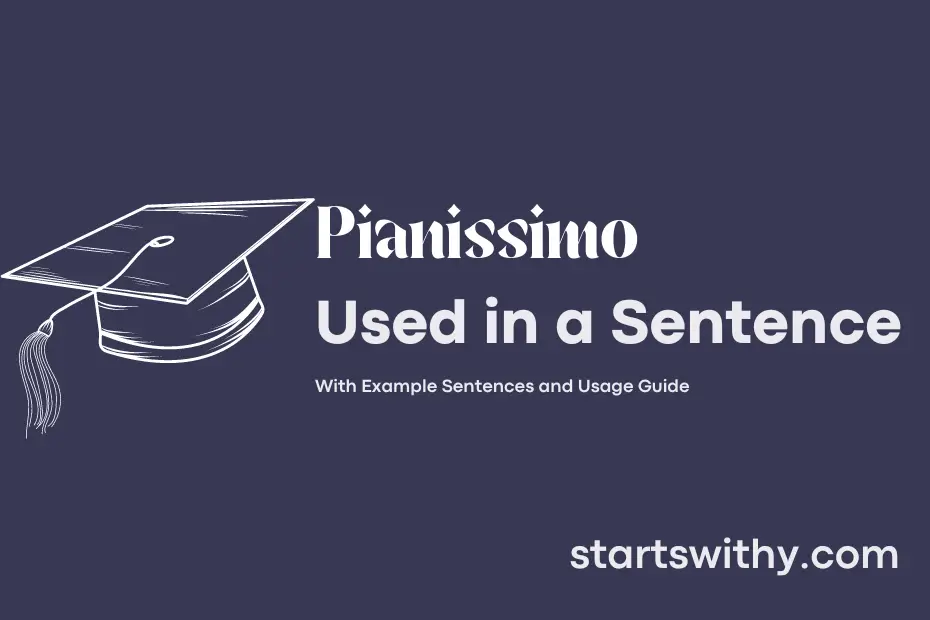Do you know what it means to play a note pianissimo? In music, the term “pianissimo” signifies a very soft and quiet dynamic level, often indicated by the abbreviation “pp” on sheet music.
It is essential for musicians to understand the concept of pianissimo, as it adds depth and emotion to their performances. By practicing control and precision in their playing, musicians can achieve the delicate and gentle quality that pianissimo is known for.
7 Examples Of Pianissimo Used In a Sentence For Kids
- Pianissimo means to play very, very quietly.
- Let’s sing the song pianissimo so we don’t wake up the sleeping baby.
- When we hear the word pianissimo, we know we need to be very silent.
- Can you tap the drums pianissimo?
- Remember to whisper pianissimo during our story time.
- We will dance gracefully and move pianissimo.
- Let’s close our eyes and breathe pianissimo to relax.
14 Sentences with Pianissimo Examples
- Pianissimo is the Italian musical term for playing very softly.
- Remember to start the piece at a pianissimo volume and gradually increase the dynamics.
- The flute section played their part with a delicate pianissimo touch.
- It is important for vocalists to master singing pianissimo for emotional performances.
- During the music theory exam, the students were asked to describe the difference between pianissimo and pianississimo.
- The violin soloist executed the final note with a perfect pianissimo ending.
- Aspiring conductors must be able to accurately communicate when they want the orchestra to play pianissimo.
- The choir practiced their harmonies in pianissimo to ensure their blended sound was seamless.
- The professor demonstrated how a slight change in bow pressure can affect the pianissimo tone on the cello.
- The music composition assignment required students to incorporate a section with a pianissimo passage.
- The Indian classical music performance captivated the audience with its mesmerizing pianissimo transitions.
- When playing the grand piano, it is essential to be in control of the pianissimo pedal for a gentle sound.
- The tabla player displayed great skill by maintaining a consistent pianissimo beat throughout the performance.
- To achieve the desired pianissimo effect, the flutist adjusted their embouchure and airspeed.
How To Use Pianissimo in Sentences?
Pianissimo is a musical term that indicates a very soft and quiet volume. When using pianissimo in a sentence, it’s important to convey the gentle and subdued nature of the sound or music being described. Here is a simple guide on how to use pianissimo effectively:
-
Placement: Place the word pianissimo in your sentence where you want to emphasize the extreme softness or quietness of the sound. It is usually used at the beginning or end of a sentence to clearly convey the intended volume level.
-
Context: Make sure the context of your sentence supports the use of pianissimo. For example, it would be appropriate to use pianissimo when describing a delicate lullaby or a light breeze rustling through leaves.
-
Pronunciation: The word pianissimo is pronounced as “pee-uh-NEE-see-moh.” Practice saying it aloud to familiarize yourself with the correct pronunciation.
-
Variation: If you want to indicate an even softer volume than pianissimo, you can use the term “pianississimo,” which means “very, very soft.” This can add an extra layer of emphasis to your description.
By following these simple guidelines, you can effectively use pianissimo in a sentence to convey the subtle and quiet nature of the sound or music you are describing.
Conclusion
In music, pianissimo refers to playing very quietly. This dynamic level is often indicated in sheet music with the abbreviation “pp.” Playing pianissimo can create a delicate and gentle sound, adding a sense of intimacy and vulnerability to a musical piece. It requires control and finesse from the musician to produce subtle and soft notes, drawing the listener in with its understated beauty.
By utilizing pianissimo in their playing, musicians can evoke a range of emotions and atmospheres, from tranquility to melancholy. The softness and control required to play pianissimo can highlight the artist’s skill and sensitivity, making it a powerful tool for musical expression. Mastering this dynamic level can greatly enhance the emotional impact and depth of a musical performance.



